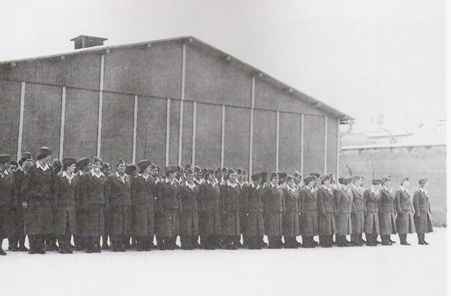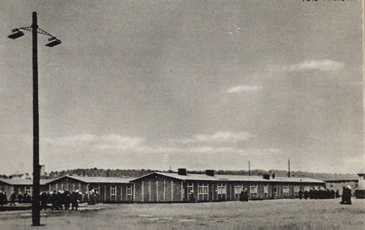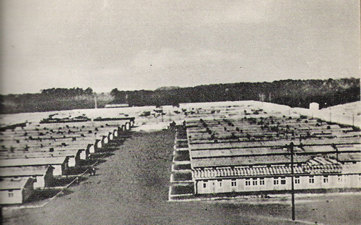 |
|
Aerial
photo made by a pilot of Air Force in 23 March 1945. The red outline
indicates area of theCamp
|
Frauenkonzentrationslager Ravensbrück located 90 km north-west of Berlin, near the small town Fürstenberg, on the shore of lake Schwedt to which river Hawela flows, was build in November 1939.
Grit Philipp in his "Kalendarium der Ereignisse in Frauen-Konzentrationslager Ravensbrück" gives 15th May, 1939 as the official date of the beginning of the camp history. At that day, no less then 310 women, most of them previously evacuated from the Lichtenburg Frauen-KL, could be found in the camp. The first available camp document dated 21 May,1939 (Gefangenenstärkemeldung des KZ Ravensbrück) shows the number of 974 registered women prisoners in the camp. Among them 388 Jehovah witnesses , 240 so called anti-social, 119 so called criminals in protective custody, 114 political prisoners, 95 due to racial defilement, 16 deportees, 2 Schulunghäftlinge. 137 Jewish women were among those first prisoners of the camp.
 |
|
Aufseherinen-the
uniformed female SS-guards
|
Nobody expected at that time that about 132,000 women representing almost 40 nations would be incarcerated in the camp throughout its entire operation until liquidation of the camp in July, 1945.
On September 23rd, 1939, the first 23 Polish women belonging to the Polish minority in Germany were incarcerated in the camp. They were active members of Polish cultural and social societies.The first 5 Polish women from Polish territory, from Pabianice, were brought to Ravensbrück on November 2nd, 1939. The mass transports of Polish women from the territories annexed by the German Reich began in April 1940. Transports from Kielce, Czestochowa, Radom, Tarnów, Kraków - and the biggest of all, from Warszawa and Lublin, came in August and September, 1941. In April, 1942, there were total of 7500 women prisoners in the camp. New transports from Radom, Czestochawa, Kielce and Warszawa as well as Lublin came in April and May, 1942. Since August 1944, then after the Warsaw Uprising collapsed, transports of total 12,000 women from the city were brought to the camp. At that time, transports of prisoners from evacuated Auschwitz (Oswiecim) also arrived. So it went on throughout September and October of 1944.
 |
|
The
camp viewed from another angle
|
It is estimated that through entire period from the date of official opening till the date of the camp liberation by Russian Army on 30th April, 1945, approximately, 40,000 Polish women were imprisoned in Ravensbrück KL(Kiedrzynska,1965 p.76).
 |
|
...and
another angle
|
On 23rd April, 1945, Mrs. Urszula Wińska, who was the camp prisoner, together with Polish members of the camp underground girl guides organization "Mury", initiated and organized smuggling, from the camp office, the most important set of documents about the history of the camp; the transport list of 25,000 prisoners with their names, the date of their arrival in the camp and the reason for the detention assigned by SS. Mrs. Wińska distributed the list, consisting 70 portfolios, among Polish women prisoners who were about to be released from the camp and sent to Sweden according to the arrangement made between Count Folke Bernadotte,the representative of the Swedish Red Cross, and Reichfürer SS H. Himmler. Additionally, in separate notebooks, Mrs. Wińska copied, from the list, dates and the numbers of prisoners in every train transports sent by SS authorities to the Ravensbrück Concentration Camp (Kiedrzynska,1965 p.13).
The documents describe, pretty accurately, the structure of the community of women incarcerated in the camp:
| Nationality | Percent |
| Poles | 24.9 |
| Germans | 19.9 |
| Jews | 15.1 |
| Russians | 15.0 |
| French | 7.3 |
| Gypsies | 5.4 |
| Ukrainians | 4.1 |
| Belgians | 2.9 |
| Czechs | 1.9 |
| Yugoslavs | 1.3 |
| Dutch | 0.4 |
| Italians | 0.35 |
| Spanish | 0.05 |
| English | 0.05 |
| Norwegians | 0.04 |
| Others | 1.28 |
| Age | Percent |
| less then 15 years old | 1.01 |
| 15-20 | 20.24 |
| 20-25 | 20,48 |
| 25-30 | 14,30 |
| 30-35 | 11,02 |
| 35-40 | 10,62 |
| 40-45 | 7,70 |
| 45-50 | 6,27 |
| 50-55 | 4,10 |
| 55-60 | 2,66 |
| over 60 years old | 1,60 |
| Description given by Gestapo | Percent |
| political | 83,54 |
| anti-social | 12,35 |
| criminal | 2,02 |
| Jehovah witness | 1,11 |
| racial defilement | 0,78 |
| other | 0,20 |
The other reasons for detention were: Ausweisungshaft,Behilfe zur Rassenschande und sog. Kuppelei, Sekte Neusalem, mit Populorum befreundet, Lesbish, Negermischling, Arierin Rassenschande, Adventistin, Emigrantin. Please see markings (triangels) worn by prisoners in Nazi concentration camps.
It also could be found on the list, in relation to Polish prisoners, descriptions like: Fanatishe Polin, mit Juden sympathisier, Mitglied des polnischen Bundes.
The community of Polish women prisoners had four distinguished characteristics: the biggest population of incarcerated in the camp, mass executions,medical experiments and the most advanced underground system of education organized by prisoners. Above all, it is amazing how under such appalling conditions, the women from Ravensbruck KL had abundance of the spiritual strength for creating pieces of art and poetry.
The ending of the camp operation under Nazis authority in two days of 27 and 28th April, 1945 had its own tragic chain of events.